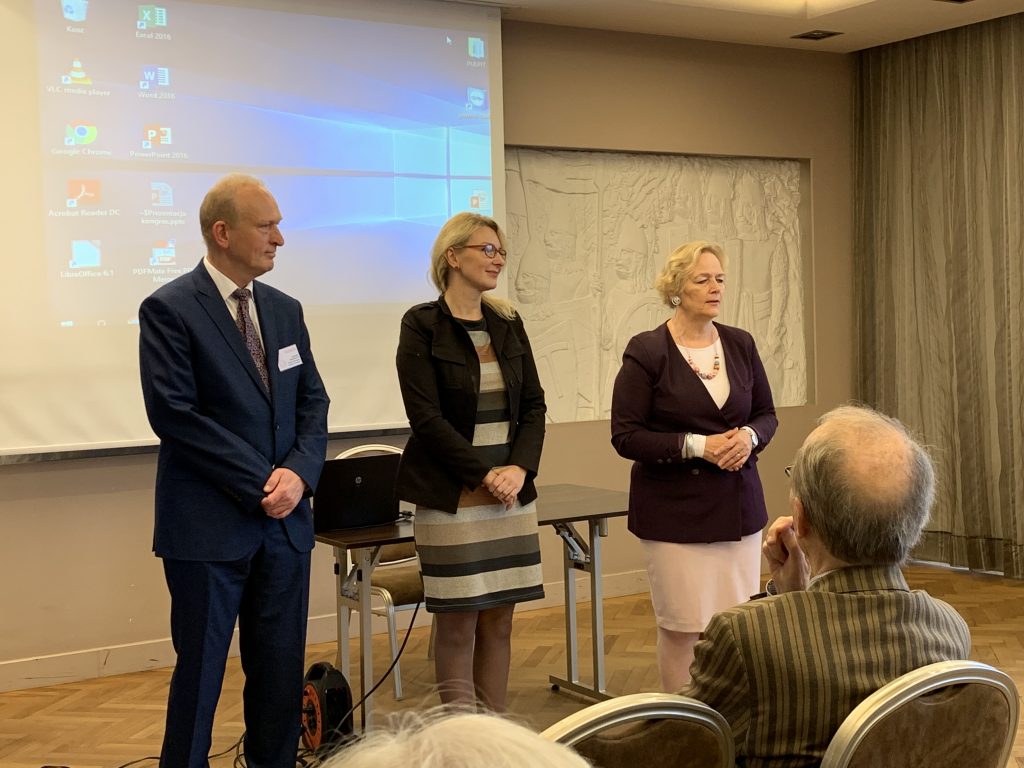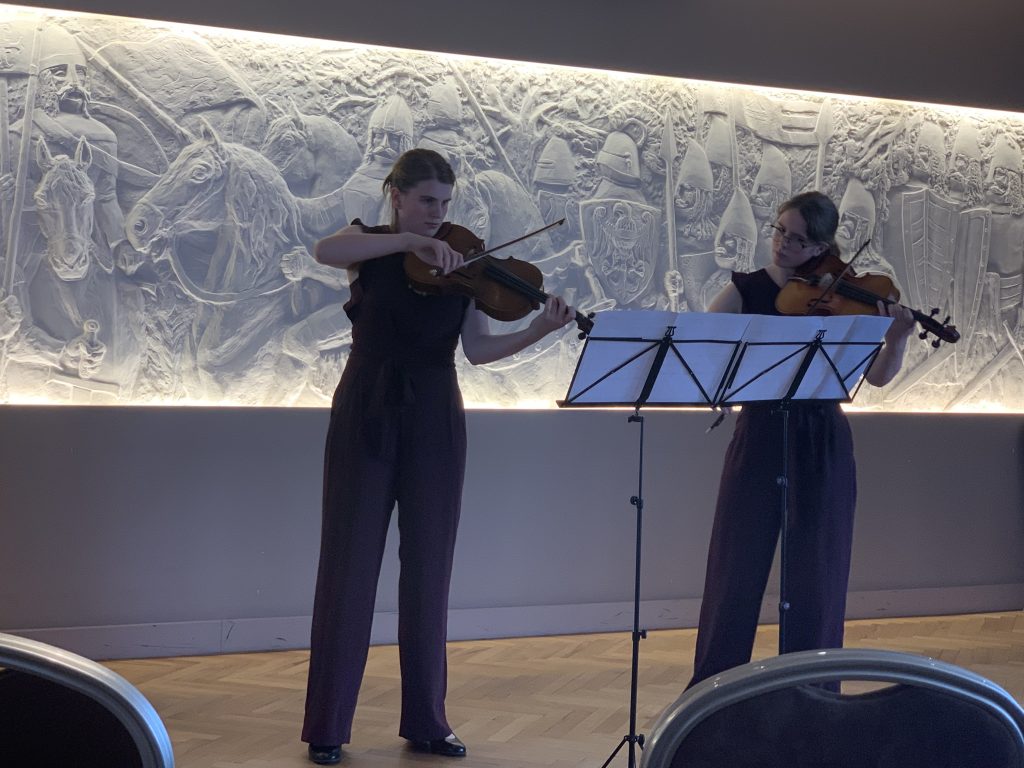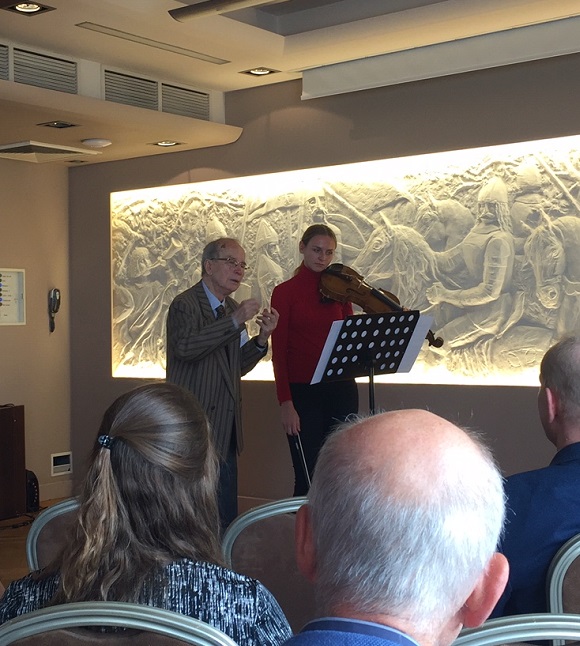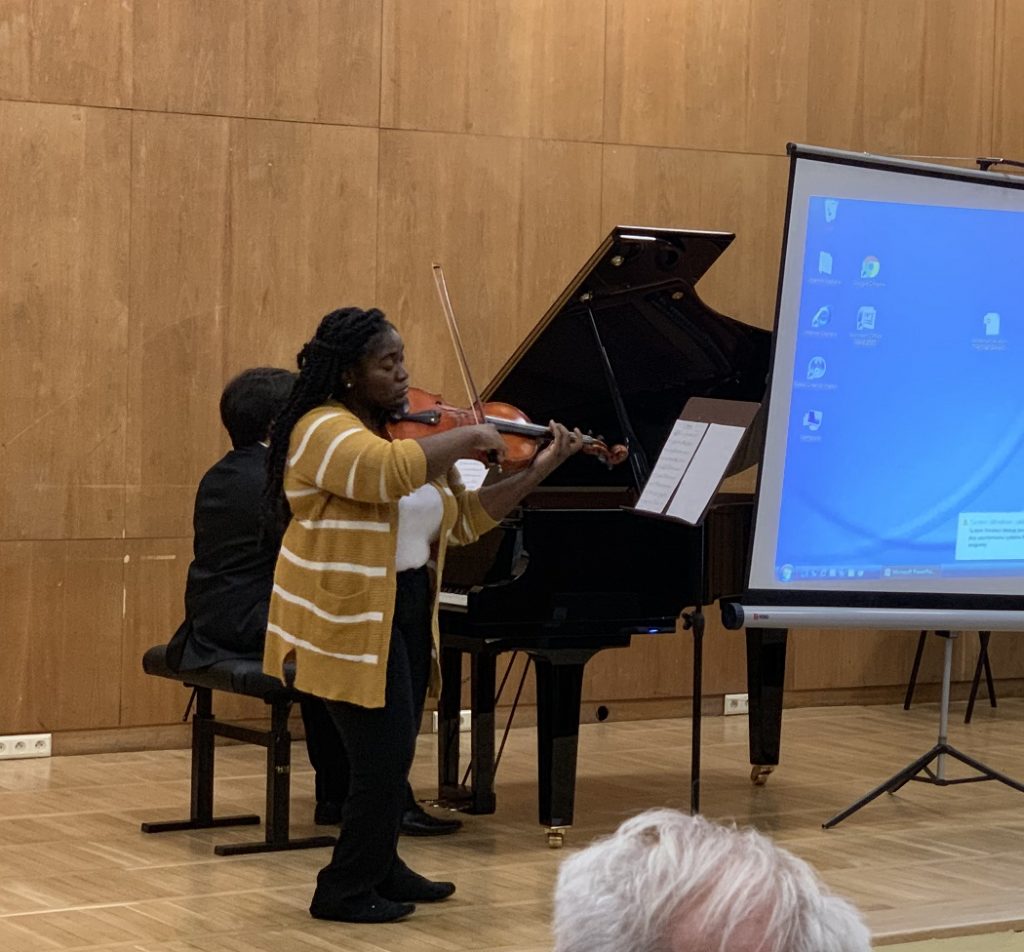The 46th International Viola Congress takes place in Poznan (Poland) from Sept. 24th – 28th, 2019. Your intrepid bloggers Karin Dolman and Kristofer Skaug bring fresh reports daily from this temporary hotspot of the viola universe.
Day 1: Tuesday, September 24th, 2019
<next day>
Well, it was a very long drive from Holland (950km), but we’re finally here in Poznan, Poland! Last night, it did not take long to convince us that Poznan has much to offer in terms of food and drinks and a very amicable old city centre.
This morning, arriving at the main venue Hotel Ikar, we found a mid-size conference room with an intriguing mural of some historic Polish (?) battle scene, but no special facilities. Before 9am, however, the room was filled with some 30-odd viola congress participants, most of which are old acquaintances by now (Karin and/or I have attended every IVC since 2013). Many more are joining in the next days…!
Many more are joining in the next days…!
Our hosts Boguslawa Hubisz-Sielska, Ewa Guzowska and Lech Balaban, welcomed us to the congress; IVS president Carlos Maria Solare threw in some words of thanks (rehearsed in Polish – which instantly made him a local hero!) and blessings for a good week. By way of anecdotes he mentioned that Henryk Wieniawski, a great violinist and one of the musical legends of Poznan and Poland, had preferred to play the viola in string quartet context. So Wieniawski now has a viola alibi, too :-).
Special guests in the category “old viola gurus” at the IVC this week are IVS Co-founder Dietrich Bauer and Polish VS Honorary president prof. Stefan Kamasa.
Except for the above, the opening ceremony was quite straightforward and unadorned by long speeches and formalities, so without further introductions we leapt head-first into the congress programme:
Jadwiga Stanek presented a lecture about the Variations for solo viola by Gordon Jacob. Written in 1975, it remains a rarely played piece, but is certainly very interesting. It was a pity that Stanek did not perform it live, but her recordings of the nine variations were very nice. She pointed out the characteristics of each variation, and concluded that the piece bears significant didactic value, for its wide range of contrasting techniques.
The next presenter was Anne Leilehua Lanzilotti, discussing the piece Sola for viola and electronics, which she commissioned from Anna Thorvaldsdottir on the occasion of the 100th anniversary of the legendary 1919 Berkshire viola composition contest. Anne first described the process of understanding and documenting the extended techniques used in this music by means of personal interviews with the composer, demonstrating the many subtle sound effects that could be produced by e.g. lateral bowing, false harmonics (“seagull effect”) and natural harmonics. In fact, Anne has created a really cool website where you can see numerous examples of such extended techniques and their notation, explained and demonstrated by composers and performers together: www.shakennotstuttered.com
 She then went on to perform the piece in full. Among the many evocative passages, in particular a long episode of cascading natural harmonics had me carried away. It was a pity that the beamer equipment in the conference room produced a very annoying low-frequency buzz, which severely interfered with softer sounds. Let’s hope they can do something about it before it makes more musical casualties!
She then went on to perform the piece in full. Among the many evocative passages, in particular a long episode of cascading natural harmonics had me carried away. It was a pity that the beamer equipment in the conference room produced a very annoying low-frequency buzz, which severely interfered with softer sounds. Let’s hope they can do something about it before it makes more musical casualties!
Next was the recital contribution (on behalf of the Dutch delegation) of the sisters Ursula and Sunniva Skaug, with the title “Related Souls: A Canonical Sister Act” – referring to their lives forming the analogy of a canon in multiple ways. The DVS logistics team had time to re-arrange the room for a more “concert friendly” layout, and fortunately we could do without the noisy conference room loudspeakers. Lutoslawski’s Bucolics for 2 violas (arranged by IVC host Hubisz-Sielska) and the serenade Related  Souls by Dutch-Canadian composer Lowell Dykstra (written for Gisella and Annette Bergman) were received well, and the Message Ground (based on the song Message in a Bottle by The Police) was a successful close-out piece. Everybody was so enthusiastic! Even I (Karin) got compliments, although I wasn’t really involved!
Souls by Dutch-Canadian composer Lowell Dykstra (written for Gisella and Annette Bergman) were received well, and the Message Ground (based on the song Message in a Bottle by The Police) was a successful close-out piece. Everybody was so enthusiastic! Even I (Karin) got compliments, although I wasn’t really involved!
After a short lunch break, the congress continued with an interesting lecture by prof. Stefan Kamasa, titled “Concerts of 20th century Polish composers”. Kamasa is former principal of the Warsaw Philharmonic and an eminent soloist, who has had the fortune to be personally involved in the early history of several 20th century Polish viola concertos: First the viola concerto by Aleksander Tansman (composed in exile, 1936-37), and the Grazyna Bacewicz concerto (commissioned by Kasama in 1968). Then there was Tadeusz Baird’s much-appraised Concerto Lugubre (1974), Roman Palester’s concerto (1976-79), and last but certainly not least, the Penderecki concerto (1983). It was a fascinating review, full of personal anecdotes and recording fragments from these concertos.
 This lecture transitioned directly into a master class, where prof. Kamasa gave advice to two Polish students: Lucja Jaskula played one of the Hindemith solo sonatas, and Justyna Robak gave a movement from one of the Bach solo suites her best shot. Although the spoken parts mostly consisted of a mix of Polish and German, the nonverbal signals (postures, gestures, and last but not least musical expressions) quickly filled the room and spoke their own language.
This lecture transitioned directly into a master class, where prof. Kamasa gave advice to two Polish students: Lucja Jaskula played one of the Hindemith solo sonatas, and Justyna Robak gave a movement from one of the Bach solo suites her best shot. Although the spoken parts mostly consisted of a mix of Polish and German, the nonverbal signals (postures, gestures, and last but not least musical expressions) quickly filled the room and spoke their own language.
The University of Tennessee viola class (studio), led by Hillary Herndon, exposed us to a new viola etude collection called “18+3”, composed by Jorge Variego. Samples of the printed book were passed around so people could read along. Most of the exercises addressed challenges with string crossings, with additional accents such as harmonics, ornamentation, shifts, double stops, and so on. The students each introduced and performed one etude (live or pre-recorded), with titles such as “Look Inside”, “Riffin”, “Uninvention”, “Beyond the rail tracks”, “Mi caramelo” and more. Altogether it formed a varied and interesting set of exercises. They are quite suitable, so I (Karin) bought a copy of the book.
Unfortunately, once again the tech support branch of the congress came up a bit short, the UT team was on their own to figure out how to hook up sound and video, and when a (grumpy) local technician finally arrived, they had already employed a workaround which got them through their routine.
Change of venue – over to the Recital hall of the next-door POSM School of Music –
Our host Boguslawa Hubisz-Sielska opened the afternoon recital with a rendition of the (to me) unknown Vieuxtemps piece “Romance on the theme of Halka (by Stanisław Moniuszko)“, technically quite demanding. Her performance gave a good view on the piece.
Next came a piece that we were really curious about, by the (African-)American composer Adolphus Hailstork (b. 1941): Sanctum for Viola and Piano, performed by  Kathryn (Katie) Brown, a regular of recent IVC’s. The music starts with a long and very personal viola solo introduction, and develops beautifully together with the piano. At one point, Brown and her pianist Théo Narayan were both improvising. It was a convincing and authentic whole. After her performance, Brown gave a short lecture championing diversified programming, while of course putting in a good word for Hailstork to this end. Hearing of the adversities faced by the composer in gaining renown, it was necessary to be reminded that Hailstork’s skin colour played an important role in Brown’s personal advocacy. We definitely have to get his music to be played more in Europe. As with many other American compositions!
Kathryn (Katie) Brown, a regular of recent IVC’s. The music starts with a long and very personal viola solo introduction, and develops beautifully together with the piano. At one point, Brown and her pianist Théo Narayan were both improvising. It was a convincing and authentic whole. After her performance, Brown gave a short lecture championing diversified programming, while of course putting in a good word for Hailstork to this end. Hearing of the adversities faced by the composer in gaining renown, it was necessary to be reminded that Hailstork’s skin colour played an important role in Brown’s personal advocacy. We definitely have to get his music to be played more in Europe. As with many other American compositions!
Rising to the challenge of an uncomfortably short dinner break, some of us found a quick pasta dish in a nearby Italian restaurant, while others sought improvised solutions such as picnicking in a nearby park. We subsequently gathered at 1900h in the POSM Main Auditorium for the “Inaugural evening concert” of this Congress.
The main part of this concert belonged to the Balaban family, in the form of a father-son duo: Violist Lech Balaban and his violinist son Jan. Together they performed a number of duets, most of quite recent date: Ewa Fabiańska-Jelińska’s Passacaglia (2018), Piotr A. Komorowski’s Albo – albo (Either – or) (2019) and Sławomir Czarnecki’s Capriccio Brda (2019). Common to these pieces was a predilection for the violin part to stay close to the viola range, not seeking the extreme of its (high) registers. Together with pianist Krzysztof Sowinski, with whom he also performed in Rotterdam last year, Lech Balaban next delivered Szymon Godziemba-Trytek’s Contemplatio in memory of his father, violinist Henryk Bałaban, who passed away 3 years ago. It was a very personal music, melancholic and introverted, including a passage with descending figures of mourning.
Together with pianist Krzysztof Sowinski, with whom he also performed in Rotterdam last year, Lech Balaban next delivered Szymon Godziemba-Trytek’s Contemplatio in memory of his father, violinist Henryk Bałaban, who passed away 3 years ago. It was a very personal music, melancholic and introverted, including a passage with descending figures of mourning.
On to some lighter material, Philipp Scharwenka’s Duo with piano accompaniment op.105. Apart from the somewhat unusual violin-viola-piano trio instrumentation, this throwback to 19th century idioms did not bring much news, in fact it is a rather long spin-out of a single theme. It struck me as a somewhat romantic but still mostly undramatic divertimento. The ending was quite funny: The viola makes a run down with some chords of the piano and violin.
 After a short break, Maxim Rysanov took the stage to perform the Shostakovich viola sonata (op.147); being the last work that Shostakovich completed before his death, it bears witness of his great love for Beethoven (esp. in the last movement). Rysanov and Sowinski brought a highly charged and very personal interpretation, with which they easily had the audience on the edge of their seats. We look forward to hearing more from Rysanov later this week.
After a short break, Maxim Rysanov took the stage to perform the Shostakovich viola sonata (op.147); being the last work that Shostakovich completed before his death, it bears witness of his great love for Beethoven (esp. in the last movement). Rysanov and Sowinski brought a highly charged and very personal interpretation, with which they easily had the audience on the edge of their seats. We look forward to hearing more from Rysanov later this week.
Due to a delayed flight, the Portuguese delegation did not make it in time for their programmed late-night session, so the first IVC2019 congress day ended here. Check back tomorrow for more news!
– Karin & Kristofer
<next day>
